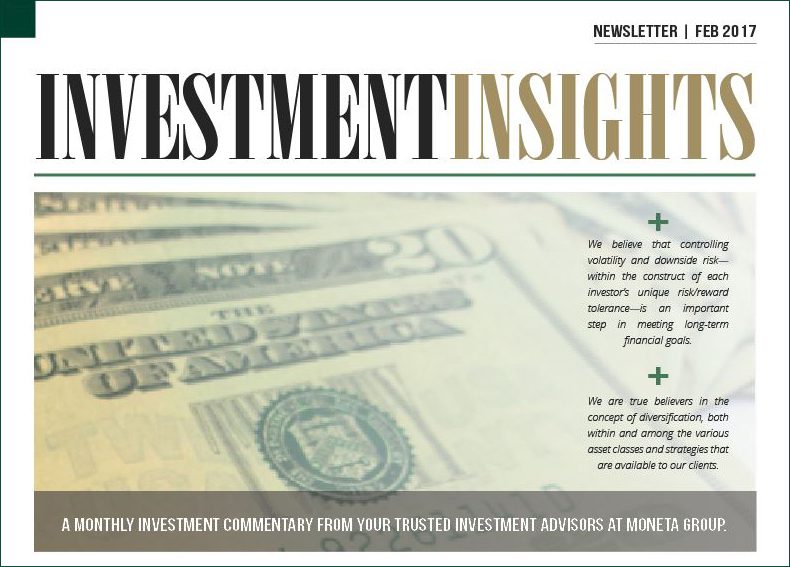by Bill Hornbarger, Chief Investment Officer
“Diversification is a risk management technique that mixes a wide variety of investments within a portfolio. The rationale behind this technique contends that a portfolio constructed of different kinds of investments will, on average, yield higher returns and pose a lower risk than any individual investment found within the portfolio.” -Investopedia
Concentration is “a large amount of something in the same place.” – Cambridge Dictionary
Since the equity markets bottomed after the global financial crisis, U.S. stocks have outperformed international equities by a fairly wide margin. For a U.S. equity investor, international diversification has lowered returns in every year since 2010, with the exception of 2012. In several of those years, international markets posted comparable or even better returns in their local currencies—but not when the relative strength of the U.S dollar was taken into account. Other traditional portfolio diversifiers, such as core fixed income and moderate volatility alternative investments, have also provided modest returns over the past several years. These results have many investors questioning the validity of portfolio diversification.
The Investopedia definition starts with the statement that “diversification is a risk management technique.” The opposite of diversification is concentration or, to put it another way, “putting all of one’s eggs in a single basket.” Investors concerned only with maximizing returns (and at the same time maximizing risk, possibly unwittingly) would choose the single-asset class or market sector, or even a single stock that they believed would provide the highest return. However, the ramifications of being wrong could quite possibly be catastrophic, and the probability of being in the “right” asset class, sector or single stock consistently through time is low. This is market timing and we have yet to meet someone with the ability to successfully do it for any reasonable length of time.
So the question remains, does diversification still work? Most individual investors are planning for long-term goals such as retirement, children’s and grandchildren’s education needs, family legacies, etc. With that in mind, let’s look at three widely held asset classes over a longer, more reasonable period of time. The four charts below show the growth of $1 invested in the S&P 500 (U.S. large-cap stocks), MSCI EAFE (international stocks) and the Bloomberg Barclays Aggregate Index (core fixed income) for four separate distinct time periods: 1980 to 1989; 1990 to 1999; 2000 to 2009; and 2010 to January 31, 2017. This period is particularly relevant since it represents the real investment environment and timeframe for many of us and a variety of market regimes, including the 1987 crash, the rise of globalization, the “tech wreck” and the global financial crisis.
Growth of $1 1980 – 1989
Source: Bloomberg


1980 -1989: International stocks outperform by a wide margin.
Growth of $1 1990 – 1999
Source: Bloomberg


1990 -1999: U.S. stocks outperform by a wide margin.
Growth of $1 2000 – 2009
Source: Bloomberg


2000 – 2009: Core bonds provided a stable return through the tech wreck and global financial crisis. International stocks outperformed between the two market crashes and ended the decade higher than U.S. stocks.
Growth of $1 2010 – January 2017
Source: Bloomberg


2010 – January 2017: The strength of the U.S. currency helped U.S. assets relative to international equities.
In behavioral finance, “recency bias” is a phenomenon where investors judge their portfolio performance on recent results (or on their perspective of recent results) and draw incorrect conclusions on how the markets behave. Most diversified portfolios have generated modest, but positive, returns the past three years. This may tempt some investors to throw in the towel and just buy the S&P or a similar proxy since U.S. stocks in general and large-cap growth in particular have performed relatively well (and better than the diversified portfolio). But this ignores history, valuations and the longer-term mean reversion tendencies of global markets. We also don’t believe concentration at record highs for many domestic equity indices is prudent.
Despite the recent frustrations, we feel that there is a good possibility that we are heading into a period where diversification will again provide benefits. Ignoring the difficulties in forecasting the next “hot” market sector or industry, the uncertainty surrounding the new administration’s policies argue for risk management through diversification. Think about it another way, what asset classes, market sectors and countries benefit from the potential for rising rates, protectionist policies, and heightened political risk and uncertainty? Or what if none of those things actually happen? Prudent investors would be even less likely than usual to concentrate their assets in such an uncertain environment.
In closing, we will stress that diversification is a risk-management strategy, not a return-enhancement strategy. The only way to be sure that you will be invested in the best performing asset class is to own all of them. Unfortunately, this ensures you will also own the poorest returning asset class. However, by appropriately sizing allocations based on individual risk-and-reward metrics, over time, diversification can mitigate drawdowns, which has historically resulted in better portfolio performance over intermediate and longer-term timeframes.
PLEASE NOTE, THESE MATERIALS WERE PREPARED FOR INFORMATIONAL PURPOSES ONLY AND DO NOT TAKE INTO CONSIDERATION YOUR INDIVIDUAL CIRCUMSTANCES. THIS NOT AN OFFER TO PURCHASE/SELL SECURITIES. PAST PERFORMANCE IS NOT INDICATIVE OF FUTURE RETURNS. ALTERNATIVE INVESTMENTS POSSESS FEATURES AND RISKS DISTINCT TO THE INDIVIDUAL INVESTMENT VEHICLE, AND ANY DECISION TO INVEST IN SUCH VEHICLES SHOULD BE MADE BASED ON YOUR INDIVIDUAL CIRCUMSTANCES IN CONSULTATION WITH APPROPRIATE FINANCIAL PROFESSIONALS.



